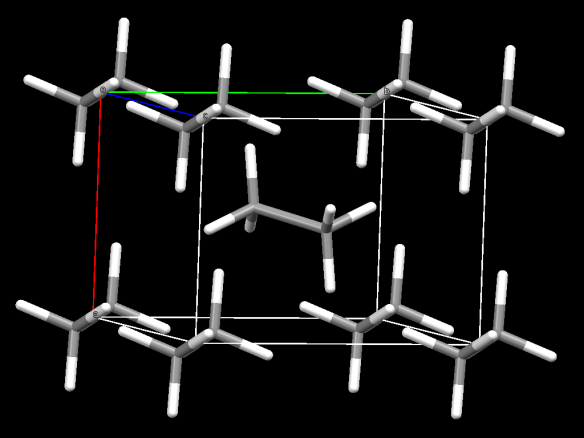An extra-terrestrial hydrocarbon – Ethane
What does it look like?

Image generated by the Mercury crystal structure visualisation software http://www.ccdc.cam.ac.uk/Solutions/CSDSystem/Pages/Mercury.aspx
What is it?
Ethane is one of the simple hydrocarbons, and has a number of uses and nuisances in wider life and industry. Like methane it's one of those materials that people only think of as a gas. But, like methane (and indeed every other gas), given cold enough conditions ethane will freeze to a solid. Ethane in particular does this at 90 K, where it becomes a plastic crystal – meaning that the molecules within the structure are rotating. This means that the structures is very simple, a pack of spheres in a body centred arrangement (like Roentgenium).
However, this plastic phase has only a very narrow range of stability; when you cool from 90 K by only 0.5 K, the rotation of the molecules stops and the structure becomes monoclinic (i.e. much less symmetric than when it first freezes.).
There are lots of reasons that this is interesting from a fundamental point of view, but when you think about the lakes of Titan the freezing of solid ethane becomes a process that could sculpt this icy moon. Titan is the only other body in our solar system known to have liquid on the surface, great seas and lakes that are thought to be made up of methane and ethane. But the surface temperature of Titan is about 90 K, so as the temperature skirts about this parts of the ocean could freeze and then melt when things got a little warmer. Could it explain the mystery 'island' observed by the Cassini spacecraft recently?
Where did the structure come from?
The structures of ethane, both the plastic and monoclinic phases, were discovered in 1978 by van Nes and Vos. This work was published in Acta Cryst, and the structures can be found in the Cambridge Structural Database (CSD) (refcode ETHANE for the plastic phase and ETHATE 01 for the monoclinic phase).






